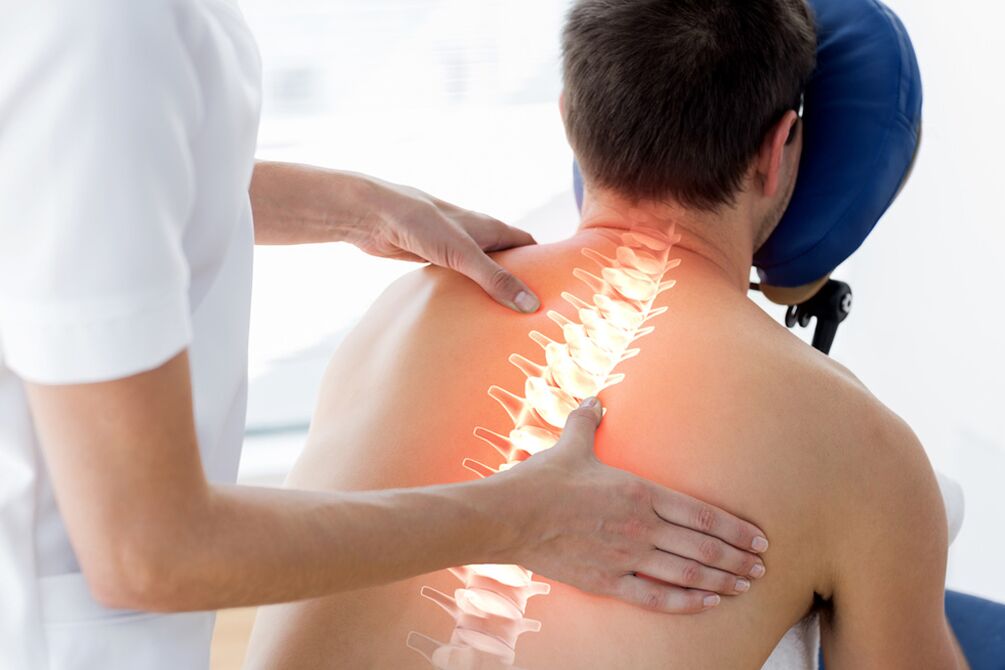Osteochondrosis of the thoracic spine involves damage to the intervertebral discs of the thoracic spine. The symptoms of the disease are similar to the manifestations of cervical and lumbar pathologies. Chest osteochondrosis is difficult and is not often diagnosed.

Symptoms of chest osteochondrosis in women
This disease is rare in women because the chest spine is less stressed than other parts of the spine. Chest osteochondrosis of the spine is quite difficult to diagnose because the disease usually manifests itself in the stage of disease progression.
The main symptom of osteochondrosis in women is pain. The pain is usually localized in the back, sternum, and can radiate to the upper extremities. In addition, a woman may suffer from stomach pain. The localization of pain depends above all on the stage of the disease.
Usually, a woman with osteochondrosis of the thoracic spine feels constant, non-intense pain. Signs of chest osteochondrosis also depend on the sensitivity and individual characteristics of the female body.
In much of humanity, the symptoms of the disease are more pronounced: the female body is more sensitive, and every part of the spine is thinner than that of the male. Women’s degenerative and dystrophic processes are more likely to cause negative reactions.
With the defeat of the thoracic section of the spine, the fair does not have the following symptoms:
- pain when raising or bending the arm;
- pain in the mammary glands;
- discomfort in the sternum, aggravated by various loads or prolonged sitting position;
- pain with deep breathing;
- severe pain between the shoulder blades in the spine;
- feeling of pressure in the chest;
- vascular dystonia.
The above symptoms are caused by processes in the spine itself. In the case of the development of intervertebral hernias, the symptoms are due to the development of vascular and neurological pathologies.
No less common manifestations of chest osteochondrosis in women are:
- frequent appearance of "goosebumps" and numbness of the shoulders and arms;
- burning sensation, coldness or itching in the lower extremities;
- pain in the heart area;
- increased brittleness of the nails, peeling of the skin;
- pathologies of gastrointestinal function: nausea, constipation or diarrhea, bloating.
Because thoracic osteochondrosis presents with symptoms similar to pneumonia, angina pectoris, or heart disease, a differential diagnosis should be made. All of the above manifestations indicate the development of chest osteochondrosis. However, it should not be self-healing. Only a doctor can make an accurate diagnosis and prescribe effective treatment.
Symptoms of chest osteochondrosis in men
Male chest osteochondrosis is often diagnosed when the spine is subjected to a high intense load (e. g. , the disease is often detected at builders, loaders, etc. ). The clinical manifestations of osteochondrosis in this case are gradual, while joint damage between the ribs and vertebrae is slow. The earlier the disease is diagnosed, the more effective the treatment will be.
In the early stages, chest osteochondrosis progresses without any particular manifestations, and a person lives without knowing that his disease is progressing. Any discomfort can usually be attributed to fatigue or an uncomfortable posture after prolonged work.
Signs of chest osteochondrosis in a man in the early stages:
- compaction of the soft tissues results in reduced elasticity in the joints and rupture between the scapulae, the sternum and the collarbone;
- reduced arm elasticity makes it difficult to lift the arms and place them behind the back;
- discomfort appears in the affected part of the chest;
- feeling of tiredness in the back after prolonged physical activity or being in a static position;
- pain occurs with deep breathing.
With further progression of the disease, the following symptoms are observed:
- the pains become more intense and continuous. Due to the constant pressure on the nerve endings, pain is observed even at rest;
- numbness, tingling in areas with impaired sensitivity;
- intermittent reflex cramps in the abdominal muscles, accompanied by discomfort;
- a man may be tortured with angina pectoris, false seizures of kidney or liver colic;
- possible disturbance of the pelvic organs and loss of potency;
- the development of osteochondrosis of the thoracic spine results in irritable bowel syndrome - a pathology of gastrointestinal function.
Symptom of coma in chest osteochondrosis
The feeling of a coma in the sternum occurs in many patients, but not everyone attaches importance to it, as this phenomenon is characterized by a short duration and disappears very quickly.
What causes this phenomenon? Usually, the feeling of coma in the sternum is due to pathologies of the nervous system. However, sometimes these feelings are caused by chest osteochondrosis because there are large amounts of nerve braids in the chest area.
This pathology often results in intercostal neuralgia. In this situation, there is pressure behind the patient's chest and there is also pain that intensifies when exercising or lifting weights. In this case, the pain resembles a needle prick and intensifies during breathing.
Osteochondrosis of the thoracic region is most often caused by improper lifestyle, sedentary work, and metabolic disorders. Conservative medication, manual and laser therapy will be the savior. Patients are encouraged to play sports or exercise.























